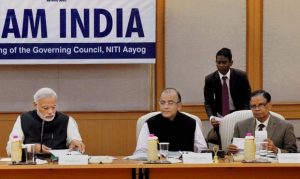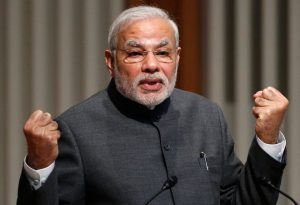
02-01-2017 (Important News Clippings)
To Download Click Here
Niti Aayog at two
It is performing vital functions that are fundamentally different from the Planning Commission

Two key activities of the Planning Commission had been to prepare and implement the Five Year Plans and to allocate financial resources to states. Neither of these activities forms a part of the mandate of Niti Aayog. The Twelfth Five Year Plan, which will conclude on March 31 this year, will be India’s last Five Year Plan.
Likewise, Niti Aayog does not allocate any financial resources to states. The 14th Finance Commission raised the share of states in the divisible pool from 32% to 42%, leaving no additional funds for allocation to states through Niti Aayog. The annual resource allocation exercise that brought state chief ministers to the doorstep of the Planning Commission is now a thing of the past.
Among many functions that Niti Aayog performs, three stand out: promotion of cooperative, competitive federalism; assisting the central government in policy making; and serving as the government’s thinktank. These three functions complement each other instead of being mutually exclusive.
The Governing Council of Niti Aayog, which includes all state chief ministers and lieutenant governors of the Union territories, set in motion the first function at its maiden meeting on February 8, 2015. It appointed three subgroups of chief ministers to advise the central government on the subjects of Centrally Sponsored Schemes, Skill Development and Swachh Bharat Mission. It also set up two task forces at the Aayog on Agricultural Development and Elimination of Poverty, with parallel task forces on each subject constituted in the states and Union territories.
Assisted by the Aayog, the subgroups completed their work and submitted the reports in relatively short time. The two task forces followed. The recommendations in the five reports have been either implemented or are under consideration.The Aayog has also helped promote reforms in the states. It has formulated a model land-leasing law, which Madhya Pradesh has adopted and Uttar Pradesh has substantially incorporated into a pre-existing law. Several other states are actively considering adopting the model law.
The Aayog is also leading a campaign to bring about major reforms in agricultural marketing. Furthermore, it has taken the initiative to help resolve and expedite decisions on numerous issues of states pending for months with various central ministries. It also identifies and spreads the best practices across states in various areas through regular interactions with state officials from relevant ministries.In its policy making role at the Centre, the Aayog has taken the initiative to identify numerous sick Public Sector units for closure. Action on 17 such units is under way. The Aayog has also identified several functioning units for strategic disinvestment. Finance ministry must now move ahead with the actual sales of these units.
A big bang reform the Aayog has proposed is the replacement of the Indian Medical Council Act, 1956, by a Medical Education Commission Act to overhaul medical education in India. The proposed Act would require entrance and exit examinations and replace input norms in the assessment of medical colleges by outcome norms.A comprehensive National Energy Policy draft is ready to be placed in public domain for wider consultation. The Aayog is also working on the creation of 20 world-class universities and reform of the University Grants Commission Act, 1956 and All India Council of Technical Education Act, 1987. It has also championed the launch of Coastal Employment Zones to accelerate the creation of well-paid jobs.
As a part of its thinktank function, the Aayog has brought out a book of best practices, conducted workshops of state officials to spread these practices, collaborated with thinktanks, created the utility India Energy Security Scenarios 2047, sponsored policy research and published several occasional papers. It is also in the process of bringing out the 15-year Vision, 7-year Strategy and 3-year Action Plan documents.It also organises the Transforming India lecture series featuring such high-profile speakers as Tharman Shanmugaratnam, Deputy Prime Minister of Singapore and Bill Gates. The Prime Minister, the entire Cabinet and the top bureaucrats attend these lectures.
The Aayog has also led the way for the creation of a vibrant innovation and entrepreneurship ecosystem in the country through its Atal Innovation Mission. The mission will soon establish tinkering labs in more than 200 schools as well as several incubators to promote innovation and entrepreneurship.Organisationally, the Aayog had inherited 1,200 positions from the Planning Commission, which it downsized to 500. Subsequently, it has taken the initiative to appoint approximately 45 young professionals and a dozen senior officers from outside. These additions have brought great energy to the institution.
When the Prime Minister invited me to join the Niti Aayog two years ago, the excitement of assisting him in the transformation of India overwhelmed the fear of taking up the challenge. I instantly accepted his generous offer. I feel proud, two years later, of what the hard-working staff of Niti Aayog have accomplished. I hope we can maintain this momentum as we step into our third year.
PM Narendra Modi offers a bounty of welfare and subsidy in his new year eve’s address

Also, the prime minister did not announce any transfer of a bounty from demonetisation to Jan Dhan accounts, as many had predicted. Rather, he described ending corruption as an ongoing project close to the hearts of the people of India, in which he solicited everyone’s cooperation. The PM has placed a huge burden on banks. A 4 per cent reduction in the interest rate on housing loans up to .Rs 9 lakh, a 3 per cent reduction in housing loans up to.Rs 12 lakh, 8 per cent assured rate of interest to senior citizens on their deposits, larger volumes of credit to small and medium enterprises, loan writeoffs for farmers, additional paperwork on enhanced credit guarantee for small businesses and an expansive mandate to lend the larger deposits that have accumulated, thanks to demonetisation, to the poor, the youth, the unemployed and the marginalised, to create a more prosperous future for them. With practised smoothness, the PM also passed on to banks the burden of bringing normalcy back, in terms of the ability to withdraw cash from bank branches and ATMs — after all, the government has done the job of directing the banks to do so.
If the already strained finances of the banks are not to fray further, the government has to provide them with budget subventions. The promise of Rs 6,000 in the bank account of every pregnant woman is a promise of the Food Security Act of 2013. While tax collections are likely to depend on how the economy absorbs the financial shock of cash being sucked out of the cash-dependent economy, the PM’s ‘handouts’ will test fiscal discipline.
सहज नियामकीय संचालन और हकीकत का आईना
अमेरिका के कैलिफोर्निया प्रांत के गवर्नर जेरी ब्राउन ने अमेरिका के नवनिर्वाचित राष्ट्रपति डॉनल्ड ट्रंप की जलवायु परिवर्तन को प्रभावित करने वाली प्रस्तावित नीतियों का सख्त विरोध किया है। पृथ्वी की निगरानी करने वाले उपग्रहों के बजट में कमी संबंधी प्रस्तावों का जिक्र करते हुए ब्राउन ने कहा, ‘अगर ट्रंप इन उपग्रहों को बंद करते हैं तो कैलिफोर्निया अपने उपग्रह छोड़ देगा। हमारे पास वैज्ञानिक हैं, हमारे पास अधिवक्ता हैं और हम लडऩे के लिए पूरी तरह तैयार हैं।’

